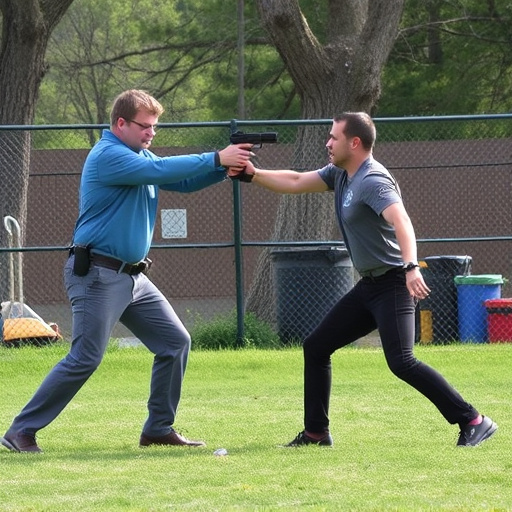Non-lethal pepper spray defense is an effective personal safety tool that temporarily incapacitates attackers, allowing users to escape or seek help. Proper handling, storage in a secure container, and understanding local laws regarding its use are crucial. Effective deployment involves accurate aiming at the attacker's face from a safe distance to disrupt vision and breathing. Legality varies by jurisdiction, with some regions permitting citizens for self-protection while others require permits or registration for law enforcement.
“Uncover the power of non-lethal pepper spray as a personal defense tool in this comprehensive guide. We explore its effectiveness, safety, and responsible usage. Learn about the chemical composition, safe handling practices, and optimal deployment techniques for this powerful self-defense weapon.
Discover legal considerations and real-world use cases, ensuring you’re prepared and informed. From understanding the spray’s range to recognizing when it’s appropriate, this article equips you with vital knowledge for enhancing your personal safety.”
- Understanding Non-Lethal Pepper Spray
- Safe Handling and Storage Practices
- Effective Deployment Techniques
- Legal Considerations and Use Cases
Understanding Non-Lethal Pepper Spray
Pepper spray, a non-lethal self-defense weapon, is designed to incapacitate an attacker temporarily, giving the user time to escape or seek help. It works by irritating the eyes and respiratory system, causing temporary blindness and difficulty breathing. This non-lethal pepper spray defense is a popular choice for personal safety due to its ease of use and minimal risk of permanent harm.
Understanding how it works is crucial. Pepper spray contains capsaicin, the same compound that makes chili peppers spicy. When activated, it releases a fine mist containing this compound, which can be breathed in or come into contact with the skin. This irritation leads to the intended effects, ensuring users have a chance to get away from dangerous situations safely.
Safe Handling and Storage Practices
Proper handling and storage are paramount when it comes to non-lethal pepper spray self-defense weapons. Always treat the spray with care, storing it in a cool, dry place away from direct sunlight or extreme temperatures. Keep it locked up tight—out of reach of children and unauthorized individuals. Regularly check the expiration date, as pepper spray can lose its potency over time.
Before using, familiarize yourself with local laws regarding self-defense and the legal implications of deploying pepper spray. Ensure you understand your rights and responsibilities. Practice safe storage habits by keeping it in a dedicated, secure container designed for carrying self-defense tools. This reduces the risk of accidental discharge and ensures the spray remains reliable when needed most.
Effective Deployment Techniques
When using non-lethal pepper spray for self-defense, proper deployment techniques are crucial. Aiming accurately and maintaining a safe distance is essential to ensure the effectiveness of the spray while minimizing harm to yourself and bystanders. Practice holding the canister firmly, targeting the face—specifically the eyes, nose, and mouth—to disrupt the attacker’s vision and breathing.
Remember that pepper spray is meant to incapacitate temporarily, giving you time to escape. Effective deployment should create a temporary barrier, not cause permanent harm. Always be aware of your surroundings and keep an eye on the wind direction to avoid blowing the spray back towards you or innocent people nearby.
Legal Considerations and Use Cases
The use of non-lethal pepper spray as a self-defense weapon is governed by specific legal considerations that vary across jurisdictions. It’s crucial to understand local laws and regulations before carrying such a device for personal safety. In many regions, pepper spray is legal for private citizens if they possess it for self-protection purposes only, and there are strict guidelines on its use. Law enforcement agencies often have different rules regarding the purchase and carry of pepper spray, typically requiring permits or registration.
Use cases for non-lethal pepper spray defense span personal safety to property protection. It can be a powerful deterrent against potential assailants, providing individuals with time to escape dangerous situations. In crowded public spaces like music festivals or sports events, pepper spray offers a swift and effective response to sudden attacks. Additionally, it has been utilized in domestic violence situations, enabling victims to temporarily incapacitate their aggressors long enough to seek help.
Pepper spray, as a non-lethal self-defense weapon, offers a powerful yet safe option for personal protection. By understanding its deployment techniques and adhering to safe handling practices, individuals can effectively utilize this tool to deter potential threats. Legal considerations vary by region, so it’s crucial to be aware of local laws regarding pepper spray use. With proper knowledge and responsibility, non-lethal pepper spray defense can empower folks to protect themselves and their loved ones while minimizing harm.
